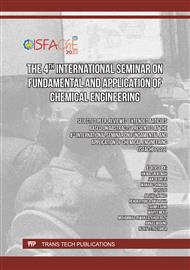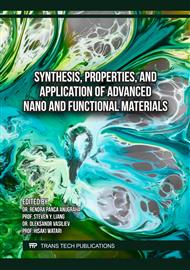p.95
p.101
p.111
p.119
p.127
p.133
p.139
p.155
p.161
Solketal Synthesis from Glycerol and Acetone Using Amberlyst-36 Catalyst
Abstract:
Recently, biodiesel production has increased condiserably due to the use of B30 in Indonesia. As a side product of biodiesel production, glycerol is also produced in large amount. Glycerol conversion to fuel additive is one of promising path for glycerol utilization. Solketal is one of fuel additives that can be derived from glycerol and it may enhance octane number on gasoline. Solketal can be synthesized from glycerol and aceton by using Amberlyst-36 as catalyst. The aim of this paper was to study the effect of catalyst loading to glycerol conversion as well as to develop a kinetic model to correlate catalyst loading to kinetic parameter. A series of experiments were conducted in a batch reactor heated in water bath, equipped with cooler, and stirrer speed at 650 rpm for 180 minutes, mole ratio glycerol to acetone is 1:4, at temperature 500 C, varying catalyst loading at 1, 3, 5, 7 wt. %. The result showed that the highest glycerol conversion was achieved as high as 88.19% at 500 C temperature using 7 wt. % of catalyst.
Info:
Periodical:
Pages:
161-166
Citation:
Online since:
February 2024
Keywords:
Price:
Сopyright:
© 2024 Trans Tech Publications Ltd. All Rights Reserved
Share:
Citation:



